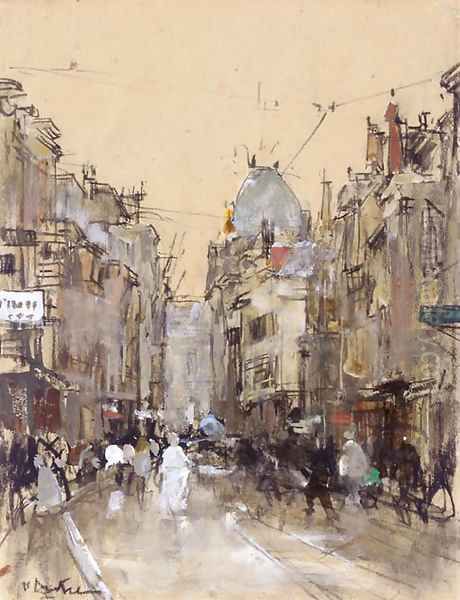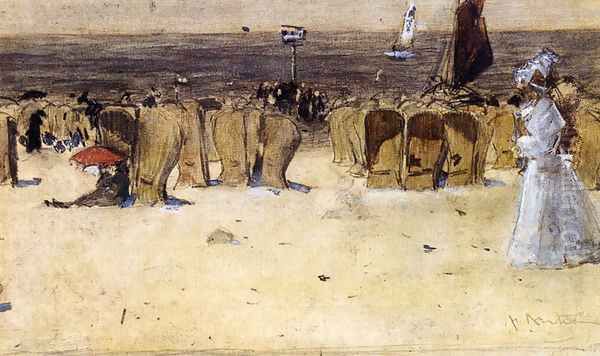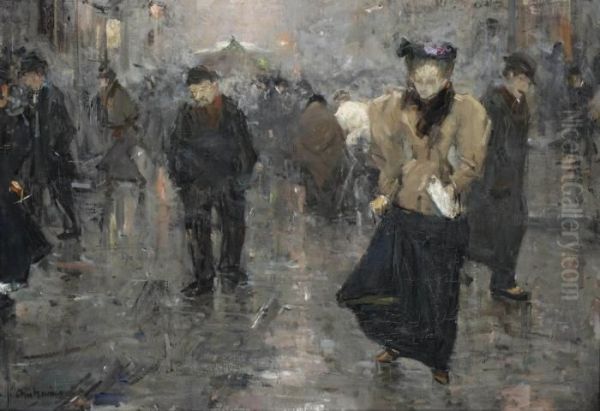
Pieter Florentius Nicolaas Jacobus Arntzenius, known to the art world as Floris Arntzenius, stands as a significant figure in Dutch art history. Born on June 9, 1864, in Surabaya, on the island of Java in the Dutch East Indies (now Indonesia), he passed away in The Hague on February 16, 1925. Arntzenius was a versatile artist, proficient as a painter, watercolorist, illustrator, and printmaker, leaving behind a body of work that captures the essence of Dutch life, particularly in The Hague, during the late 19th and early 20th centuries.
Arntzenius is often associated with the younger generation of the Hague School, a movement known for its realistic depictions of Dutch landscapes and everyday life. His artistic style, however, occupies a unique space, bridging the tonal realism of the Hague School with the brighter palette and looser brushwork characteristic of Impressionism. This blend allowed him to create evocative scenes filled with atmosphere and nuanced observations of light and weather.
Early Life and Artistic Formation
Floris Arntzenius's journey into the art world began far from the Dutch landscapes he would become famous for painting. His birth in Surabaya provided an early, albeit brief, exposure to a different environment before his family relocated to the Netherlands. This move proved pivotal, setting the stage for his formal artistic education in Amsterdam.
He enrolled at the prestigious Rijksakademie van Beeldende Kunsten (Royal Academy of Fine Arts) in Amsterdam. There, he received foundational training under the guidance of Frederik Nachtweh. His education was further enriched by instruction from other notable figures at the academy, including August Allebé and Barend Wijnveld. These teachers would have grounded him in the academic traditions and techniques prevalent at the time, providing a solid base for his future development.
Seeking to broaden his artistic horizons, Arntzenius continued his studies abroad. He spent two years at the Koninklijke Academie voor Schone Kunsten (Royal Academy of Fine Arts) in Antwerp, Belgium. During this period, he studied under Charles Verlat, a respected Belgian painter known for his historical scenes, animal paintings, and portraits. This experience in Antwerp likely exposed Arntzenius to different artistic currents and further refined his technical skills.
Settling in The Hague and Artistic Focus

The year 1892 marked a significant turning point in Arntzenius's life and career. He moved to The Hague, accompanying his mother, and this city would become his primary source of inspiration for the remainder of his life. Almost immediately upon arrival, he immersed himself in the local art scene, becoming a member of the influential Pulchri Studio, a society of artists based in The Hague. This membership connected him with fellow artists and provided opportunities for exhibition and exchange.
His engagement with the artistic community deepened further in 1896 when he joined the Hollandsche Teekenmaatschappij (Dutch Watercolour Society). This affiliation underscored his commitment to watercolor, a medium in which he excelled, alongside his work in oils and printmaking. The Hague, with its elegant streets, bustling markets, nearby beaches, and often overcast skies, offered Arntzenius a wealth of subject matter perfectly suited to his temperament and evolving style.
He became particularly renowned for his depictions of the city's urban landscapes. Unlike some contemporaries who might set up easels directly on the street, Arntzenius often faced challenges painting freely in public spaces. To overcome this, he reportedly developed a practice of renting rooms or using windows overlooking busy streets. This vantage point allowed him to observe the flow of daily life – pedestrians, carriages, trams, market stalls – and capture the specific atmospheric conditions of the moment, often under grey or misty skies.
Artistic Style and Techniques
Floris Arntzenius developed a distinctive artistic style characterized by its sensitivity to light, atmosphere, and the subtleties of urban life. While rooted in the realist traditions of the Hague School, his work increasingly incorporated elements associated with Impressionism. This resulted in paintings that were both accurate in their depiction of place and time, yet imbued with a subjective, atmospheric quality.
He demonstrated a remarkable ability to capture the effects of weather, particularly the damp, overcast conditions common in The Hague. His cityscapes often feature wet streets reflecting the sky, figures huddled under umbrellas, or scenes veiled in mist. This focus on specific atmospheric effects, rendered with nuanced tonal variations and often muted colours, became a hallmark of his work. He masterfully used light and shadow not just for descriptive purposes, but to create mood and emphasize the transient beauty of everyday moments.

Arntzenius was adept in several media. His oil paintings possess a tangible quality, with visible brushwork that contributes to the overall texture and vibrancy of the scene. His watercolors are particularly celebrated for their fluidity and transparency, effectively conveying the dampness of the air or the delicate play of light. He was also a skilled printmaker and illustrator, contributing drawings to publications such as Elsevier's Geïllustreerd Maandschrift, showcasing his versatility and draughtsmanship.
Key Themes and Subjects
The city of The Hague was undoubtedly Arntzenius's principal muse. He repeatedly turned his attention to its streets, squares, and canals, capturing the rhythm of urban existence at the turn of the century. Busy thoroughfares like the Spuistraat and the Veenestraat appear frequently in his oeuvre, depicted with an eye for detail and a feel for the energy of the crowd. He painted shoppers, horse-drawn trams, flower sellers, and the general populace going about their daily business, creating a vivid portrait of the city.
Beyond the urban core, Arntzenius was also drawn to the nearby coastal landscape. The beaches of Scheveningen and Noordende provided another rich source of subjects. His beach scenes often depict figures strolling along the shore, children playing, or the characteristic fishing boats, known as bomschuiten, resting on the sand. These works often contrast the vastness of the sea and sky with the human activity along the coast, again paying close attention to the prevailing light and weather.
While best known for his cityscapes and beach scenes, Arntzenius also produced accomplished still lifes. Works such as Chrysanthemums in a Vase reveal his skill in composition and his appreciation for the beauty of everyday objects. These paintings often feature rich colours and textures, demonstrating another facet of his artistic talent. Throughout his diverse subjects, a consistent thread is his focus on capturing fleeting moments and the specific atmosphere of a scene.
Representative Works
Several paintings stand out as representative of Floris Arntzenius's style and thematic concerns. His depictions of The Hague's streets are perhaps his most iconic works. Spuistraat, a subject he returned to, exemplifies his ability to render the bustling energy of urban life under characteristic Dutch skies. One version, dated 1919, captures the movement of pedestrians and vehicles with fluid brushstrokes and a keen sense of atmospheric perspective. Another notable street scene is his portrayal of the Veenestraat.

His beach scenes are equally significant. Works titled Figures on the Noordende beach and Figures on the beach Scheveningen showcase his interest in coastal life and landscape. These paintings often feature loosely painted figures integrated into the expansive setting of sand, sea, and sky, emphasizing the mood and light particular to the seaside environment.
Other important works highlight different aspects of his output. Riding in the Snow (circa 1895), housed in the Kunstmuseum Den Haag (formerly Haags Gemeentemuseum), demonstrates his ability to capture winter scenes with atmospheric depth. Girl with Fire Lighters (circa 1890), reportedly held in the collection of the Landesmuseum Mainz, shows his skill in figure painting and capturing intimate, everyday moments. His still life, Chrysanthemums in a Vase, further illustrates the breadth of his subject matter and technical proficiency.
Connections and Contemporaries
Floris Arntzenius was an active participant in the Dutch art world of his time. His membership in societies like Pulchri Studio in The Hague and Arte et Amicitiae in Amsterdam placed him at the heart of artistic discourse and exhibition opportunities. Through these affiliations and his studies, he interacted with many prominent artists.
Among his notable contemporaries were figures who, like him, navigated the transition from Hague School realism towards Impressionism. He maintained a close relationship with George Breitner, another major painter known for his dynamic depictions of urban life, particularly in Amsterdam. Isaac Israëls, a former classmate from the Rijksakademie and son of the Hague School master Jozef Israëls, was another key contemporary whose work often paralleled Arntzenius's interest in modern life and looser brushwork.
Arntzenius was also acquainted with established masters of the Hague School, including the Maris brothers. He counted both Jacob Maris and Willem Maris among his friends and colleagues within the Hague art community. Furthermore, sources mention a period of collaboration or shared activity with the artist Cornelis van der Veen. These connections highlight Arntzenius's position within a network of influential Dutch artists who were collectively shaping the direction of painting in the Netherlands. His teachers – Frederik Nachtweh, August Allebé, Barend Wijnveld, and Charles Verlat – also form part of his artistic lineage.
Career, Recognition, and Exhibitions
Throughout his career, Floris Arntzenius achieved a degree of recognition, though perhaps not the widespread fame of some of his contemporaries during his lifetime. He actively exhibited his work both domestically and internationally. His paintings were shown in major exhibitions in cities such as Munich, Venice, Paris, and Brussels, bringing his depictions of Dutch life to a wider European audience.
His work found favour with collectors, and his paintings, particularly his watercolors and cityscapes, performed well at auctions, indicating a consistent market appreciation for his art. Evidence suggests his works received awards at various exhibitions, further cementing his reputation within art circles. Beyond his painting, his work as an illustrator for publications like Elsevier's Geïllustreerd Maandschrift provided another avenue for his artistic expression and income.
From 1910 onwards, Arntzenius also engaged in teaching, opening his own studio where he primarily instructed students in the art of portraiture. This indicates his standing within the Hague art community had reached a point where he could pass on his knowledge to a younger generation. Despite these successes, sources suggest that broader acclaim and deeper appreciation for his unique contribution grew significantly after his death. Today, his works are held in important public collections, including the Kunstmuseum Den Haag and the Rijksmuseum in Amsterdam, ensuring his legacy endures.
Personal Life and Legacy
Floris Arntzenius's personal life appears to have been relatively private and centered around his dedication to his art. He never formally married. However, he shared a significant part of his life with Lide Doornooij, with whom he had two daughters. This domestic arrangement, while perhaps unconventional for the time, suggests a stable personal background that supported his artistic pursuits.
His life was tragically cut short by illness. Floris Arntzenius died from tuberculosis on February 16, 1925, in The Hague, the city he had so meticulously observed and lovingly painted for over three decades. He was sixty years old at the time of his death.
The legacy of Floris Arntzenius lies in his sensitive and atmospheric depictions of Dutch urban and coastal life at the turn of the 20th century. As a key figure of the later Hague School, infused with Impressionist sensibilities, he captured the specific mood and character of The Hague with a unique blend of realism and painterly finesse. His focus on everyday scenes, his mastery of light and atmosphere, particularly in rendering the effects of weather, and his skillful use of both oil and watercolor secure his place as an important Dutch artist. His work continues to be admired for its evocative power and its intimate portrayal of a bygone era.